The NVIDIA GeForce GTX 980 Ti Review
by Ryan Smith on May 31, 2015 6:00 PM EST
For much of the last year now, the story of the high-end video card market has been the story of NVIDIA. In September of 2014 the company launched the GeForce GTX 980, the first and at the time most powerful member of their Maxwell 2 architecture, setting a new mark for both power efficiency and performance, securing their lead of high-end of the video card market. NVIDIA then followed that up in March with the launch of the GeForce GTX Titan X, NVIDIA’s true flagship Maxwell part, and a part that only served to further cement their lead.
Based on the very powerful (and very large) GM200 GPU, GTX Titan X is currently untouched in performance. However priced at $1000, it is also currently untouched in price. In NVIDIA’s current lineup there is a rather sizable gap between the $550 GTX 980 and $1000 GTX Titan X, and perhaps more significantly GTX Titan X was the only GM200 part on the market. With NVIDIA launching their fully enabled flagship card first, it was only a matter of time until they released a cheaper card based on a cut-down version of the GM200 GPU in order to fill that pricing hole and to put salvaged GM200s to good use.
Now just a bit over two months since the launch of the GTX Titan X, NVIDIA launching their second GM200 card, GeForce GTX 980 Ti. Based on the aforementioned cut-down version of GM200, GTX 980 Ti is the expected junior version of GTX Titan X, delivering GM200 at a cheaper price point. But calling GTX 980 Ti a cheaper GM200 may be selling it short; “cheaper” implies that GTX 980 Ti is a much lesser card. At $649, GTX 980 Ti is definitely cheaper, but the card that is launching today is not to be underestimated. GTX 980 Ti may be intended to be GTX Titan X’s junior, but with the excellent performance it delivers, GTX 980 Ti may as well be GTX Titan X itself.
| NVIDIA GeForce Specification Comparison | ||||||
| GTX Titan X | GTX 980 Ti | GTX 980 | GTX 780 Ti | |||
| CUDA Cores | 3072 | 2816 | 2048 | 2880 | ||
| Texture Units | 192 | 176 | 128 | 240 | ||
| ROPs | 96 | 96 | 64 | 48 | ||
| Core Clock | 1000MHz | 1000MHz | 1126MHz | 875MHz | ||
| Boost Clock | 1075MHz | 1075MHz | 1216MHz | 928Mhz | ||
| Memory Clock | 7GHz GDDR5 | 7GHz GDDR5 | 7GHz GDDR5 | 7GHz GDDR5 | ||
| Memory Bus Width | 384-bit | 384-bit | 256-bit | 384-bit | ||
| VRAM | 12GB | 6GB | 4GB | 3GB | ||
| FP64 | 1/32 FP32 | 1/32 FP32 | 1/32 FP32 | 1/24 FP32 | ||
| TDP | 250W | 250W | 165W | 250W | ||
| GPU | GM200 | GM200 | GM204 | GK110B | ||
| Architecture | Maxwell 2 | Maxwell 2 | Maxwell 2 | Kepler | ||
| Transistor Count | 8B | 8B | 5.2B | 7.1B | ||
| Manufacturing Process | TSMC 28nm | TSMC 28nm | TSMC 28nm | TSMC 28nm | ||
| Launch Date | 03/17/2015 | 06/01/2015 | 09/18/2014 | 11/07/2013 | ||
| Launch Price | $999 | $649 | $549 | $699 | ||
Taking a look at GTX 980 Ti from a specifications perspective, NVIDIA’s latest card is in a somewhat unusual place. Its direct predecessor, GTX 780 Ti, was a fully enabled GK110 card, differing from that generation’s Titan only in double precision compute capabilities and a trivial clockspeed difference. However with GM200 being a pure graphics chip – and hence GTX Titan X not pulling double-duty as a prosumer level compute card – NVIDIA has needed to turn to cutting down the chip itself in order to differentiate the products. In this sense the GTX 980 Ti is probably closer to being the GTX 780 of its generation, a very timely situation given the fact that GTX 780 launched almost exactly 2 years ago.
In any case, compared to GTX Titan X NVIDIA has made just two changes to create GTX 980 Ti. The first is that the company has disabled 2 of GM200’s 24 SMMs, bringing it down to 22 SMMs for a total of 2816 active CUDA cores. The second change was to dial back the amount of VRAM, from GTX Titan X’s 12GB to the 6GB we see on GTX 980 Ti. And that’s it.
In every other aspect the GTX 980 Ti is identical to the GTX Titan X. Both are clocked at 1000MHz, with a boost clock of 1075MHz. Both feature their VRAM on a 384-bit memory bus with their respective VRAM modules clocked at 7GHz. Both are set for a 250W TDP, and are equipped with NVIDIA’s high end metal-shrouded cooler. And finally, GTX 980 Ti retains all 96 ROPs and 3MB of L2 cache, which means that in pixel-heavy situations like 4K it is as no disadvantage compared to GTX Titan X.
Consequently, looking at the specifications tells us that we should expect GTX 980 Ti to be 8% slower than GTX Titan X, a result of losing 2 SMMs. Coupled with the difference in VRAM between the two cards, this would put a decent gap between the two cards. However as we’ll see in our benchmarks, reality begs to differ. Thanks to the combination of a couple of factors GTX 980 Ti ends up coming much closer to GTX Titan X than what the specifications tell us to expect. In the end what we find is that it delivers 97% of GTX Titan X’s performance. This, in a nutshell, is what makes GTX 980 Ti a deceptive card, and is why it’s going to have such a large impact on the high-end market.
Shifting gears, let’s talk about pricing, availability, and the competition. The GTX 980 Ti will be a hard launch, with cards going on sale on June 1st. Due to the fact that Computex is taking place this week in Taiwan and GTX 980 Ti is one of the products NVIDIA is launching at the show, NVIDIA has lifted the embargo on GTX 980 Ti at an atypical 6pm Eastern, which for Taiwan and Computex is June 1st, 6am local time. NVIDIA is launching the card globally on the 1st, so in a reversal of typical launches APAC buyers will get first dibs on the card, followed by European and North/South American buyers several hours later. Along with the GTX 980 Ti reference cards launching today, expect to see semi-custom cards launching very soon thereafter.
Meanwhile for pricing, the GTX 980 Ti will be launching at $649. This is an increasingly persistent price point for NVIDIA that has fluctuated a bit over the last couple of years, with the GTX 780 launching at $649 as well, only for the GTX 780 Ti to launch at $699. The launch of GTX 980 Ti at $649 will be putting pressure on the rest of NVIDIA’s product stack from both above and below. In response to this launch NVIDIA is officially cutting the price of the GTX 980 from $549 to $499 in order to open up a bit more room between the cards and to keep GTX 980 Ti from making GTX 980 redundant. At the same time however GTX 980 Ti puts enormous pressure on GTX Titan X; GTX 980 Ti’s performance is close enough to GTX Titan X that the latter’s only practical advantage is its 12GB of VRAM, and that’s not a lot to justify the Titan’s $350 (54%) price premium.
Not stopping there, in an unusual move for NVIDIA the GTX 980 Ti is getting a game bundle right off the bat. The card isn’t getting NVIDIA’s full Two Times The Adventure bundle that comes with the GTX 980, but it is getting a copy of the forthcoming Batman: Arkham Knight, another one of this year’s major GameWorks titles. The end result is that NVIDIA is being more aggressive than usual this time around, offering what amounts to a GTX Titan X and a game for $649.
Of course the competition may have something to do with it. AMD is pretty much shouting from the rooftops that they are launching a new high-end video card this quarter, which at this point means the card is due by the end of June. While NVIDIA does have other financial incentives for releasing GTX 980 Ti now that GTX Titan X has been on the market for a couple of months, by all appearances this looks to be NVIDIA making the first move. We’ll have to see just what AMD delivers next month, but what is clear is that whatever they do, NVIDIA will not be making it easy by delivering flagship performance at $649.
In the meantime AMD and their partners are also still selling the Radeon R9 295X2 for around $600, though it looks like this is part of an effort to sell off the remaining inventory of cards. AMD has no other cards in this price range, so the GTX 980 Ti is otherwise uncontested until AMD’s new card launches.
| Summer 2015 GPU Pricing Comparison | |||||
| AMD | Price | NVIDIA | |||
| $999 | GeForce GTX Titan X | ||||
| $649 | GeForce GTX 980 Ti | ||||
| Radeon R9 295X2 | $599 | ||||
| $499 | GeForce GTX 980 | ||||
| Radeon R9 290X | $319 | GeForce GTX 970 | |||
| Radeon R9 290 | $250 | ||||












290 Comments
View All Comments
jjj - Sunday, May 31, 2015 - link
lol they got way high margins on the big cards ,they could sell this easily at 500$ (where perf per price would be close to the 970) and have good margins, if AMD has the big enough card, all they need is to want to be price competitive.These are not products for people that look for reasonable value, nobody that looks for that would ever pay 500$ for a GPU to begin with so both AMD and Nvidia are just keeping the high margins since volumes can't really go up.
Yojimbo - Sunday, May 31, 2015 - link
I don't know how you can say the value is unreasonable when there is no other way to achieve what these cards achieve. The high end of the graphics market is less sensitive to price than more mainstream segments. Both AMD and NVIDIA are trying to maximize their profits over the entire market range.jjj - Sunday, May 31, 2015 - link
You seem to not understand the term value and then you explain why the high end cards are poor value.Value and competitiveness are 2 different things. One is perf per price and the other is how the product relates to it's competitors. Yes the high end is less price sensitive (something my first comment agreed with) and the cards are poor value that's why i found it amusing that someone thinks the perf per price is great, when it never is in the category.
Daroller - Monday, June 1, 2015 - link
"You do not seem to don't understand the term value, and then you explain why the high end cards are poor value."Oh, that's rich.
Value in this case is a subjective term. Each consumer defines the value of a product to them. It isn't something you can put on a chart, or quantify, unless that's how they choose to define it for themselves.
I own two TITAN X in SLI to drive a 1440p display. You'd probably call that "poor value". You'd be correct... for yourself. You'd be woefully incorrect if we're discussing what I consider "value", because I considered the price/performance ratio to be perfectly acceptable, and moreover, a "good deal" to eliminate all possibility of VRAM related stuttering. All this while giving me the same number of shader cores as a tri-SLI 980 setup with better scaling because it's only two cards. A resounding value in my books.
Refuge - Monday, June 1, 2015 - link
lol, you lost all credibility with anyone here after you said you were using Titan X's in SLI because you are worried about running out of VRAM and stuttering...I wouldn't call that poor value, I would just call that retarded.
Yojimbo - Monday, June 1, 2015 - link
And yet despite his lack of "credibility" everything he said was completely correct. What does that say about your ability to judge?Kutark - Monday, June 1, 2015 - link
This whole thread could have been fixed if the guy said "objectively" instead of just "value".Yes, what constitutes a good value varies from person to person. Anyone with a brain can infer what he was trying to say in his argument, which is absolutely correct, is that at this price bracket, people aren't buying cards based on price/perf. So, whether or not the price/perf is comparable to lower cards is irrelevant. They price according to what the market will be bear. If they're selling them as fast as they can make them, then they're selling them at the right price.
Yojimbo - Tuesday, June 2, 2015 - link
No. Especially since he replied back to me and ridiculed me for not knowing what "value" is. That by itself is enough of a refutation of your "just try to guess what he meant" argument. But if he really did mean what you think he did, his post is irrelevant, because value is the proper metric, and it is not "objective". That really is the entire point, and why something needed to be said.Yojimbo - Tuesday, June 2, 2015 - link
And one more thing. The fact that they aren't buying the cards to maximize "price/perf" is blatantly obvious, and just as blatantly irrelevant. The problem I'm having is, and I could be wrong here, that you and he both seem to be convinced they SHOULD be buying the cards on "price/perf."mapesdhs - Wednesday, June 3, 2015 - link
I'd buy you a beer for posting that if I could. 8) It's the perfect summation of what I've said so often, namely an item is only ever worth what someone is willing to pay. It's funny how people can get so offended that someone else can afford and is happy to buy a far better config than they do; really it's just hidden jealousy IMO. Either way, kudos for that rig, and please post some 3DMark bench links! 8) Actually, you should buy the beer, you can afford it, hehe...I wonder if you have a similar MO to me, I like to max out visual settings for the games I play, modding if need be to improve visuals. I hate scenery popping, etc.